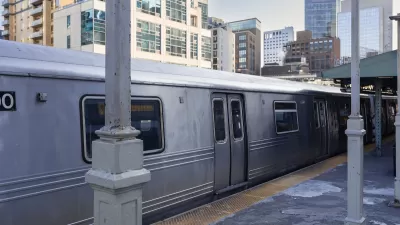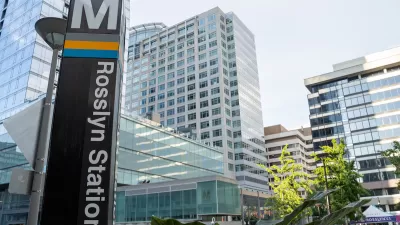The Los Angeles County Metropolitan Transportation Authority (Metro) is implementing a new vision for "transit-oriented communities."
To help achieve its new goal of developing transit-oriented communities, Metro recently revised the process by which it develops Metro-owned land, increasing its commitment to affordable housing, collaboration with local jurisdictions, and community engagement.
"TOC is a comprehensive look at how a rail station or a joint-development site at a rail station impacts a broader community context," Jenna Hornstock, who oversees Metro's Joint Development Program, explains in The Planning Report. "Within Joint Development, we’re moving beyond the goal of 'getting a project done on Metro-owned land.'"
On the ground, the new set of goals guide the development process from the pre-planning stages:
"For our joint development sites, we ask: What are the community development goals of that area? What kinds of amenities are needed in that community? What are the opportunities for active transportation connections at our site? How can the perimeter of the site link into investments we know might be coming for active transportation? How do we use that site to instigate and support further investment in the infrastructure?"
Working toward an enriched agenda, with more considerations, ambitions, and impacts, has required Metro to collaborate with more stakeholders. The agency is now developing closer partnerships with local municipalities to share information, expertise, and resources.
"With no redevelopment tax-increment available, we’re all going to have to get creative and bring something to the table," Hornstock says.
What Metro brings to the table is primarily land—as well as long-term investment in infrastructure, planning grants, and a sizable staff. Cities and municipalities can leverage local and federal dollars, and exercise control and flexibility over land-use regulations. Metro is also looking to newly created tools, like AB 2's Community Revitalization Investment Areas and Enhanced Infrastructure Financing Districts.
Fortunately, the benefits of this comprehensive work can also be multifold; if transit works to provide community amenities, amenities can encourage communities to use transit:
It all links back to creating more mobility options for communities and supporting public transit. The more we can center communities around public transit, through our joint-development sites and other targeted investments, the more people will get out of their cars and find other modes of transportation.
Hornstock also oversees Metro's Union Station Master Plan, which, likewise, entails collaboration with other agencies—specifically SCRIP and High-Speed Rail—to achieve co-benefits—in this case for bikes, pedestrians, rail, buses, and HSR. Read more on the changes coming to L.A.'s Union Station in The Planning Report.
FULL STORY: Metro’s Joint Development Goal: Transit Oriented Communities

Alabama: Trump Terminates Settlements for Black Communities Harmed By Raw Sewage
Trump deemed the landmark civil rights agreement “illegal DEI and environmental justice policy.”

Study: Maui’s Plan to Convert Vacation Rentals to Long-Term Housing Could Cause Nearly $1 Billion Economic Loss
The plan would reduce visitor accommodation by 25% resulting in 1,900 jobs lost.

Planetizen Federal Action Tracker
A weekly monitor of how Trump’s orders and actions are impacting planners and planning in America.

Wind Energy on the Rise Despite Federal Policy Reversal
The Trump administration is revoking federal support for renewable energy, but demand for new projects continues unabated.

Passengers Flock to Caltrain After Electrification
The new electric trains are running faster and more reliably, leading to strong ridership growth on the Bay Area rail system.

Texas Churches Rally Behind ‘Yes in God’s Back Yard’ Legislation
Religious leaders want the state to reduce zoning regulations to streamline leasing church-owned land to housing developers.
Urban Design for Planners 1: Software Tools
This six-course series explores essential urban design concepts using open source software and equips planners with the tools they need to participate fully in the urban design process.
Planning for Universal Design
Learn the tools for implementing Universal Design in planning regulations.
Caltrans
Smith Gee Studio
Institute for Housing and Urban Development Studies (IHS)
City of Grandview
Harvard GSD Executive Education
Toledo-Lucas County Plan Commissions
Salt Lake City
NYU Wagner Graduate School of Public Service





























